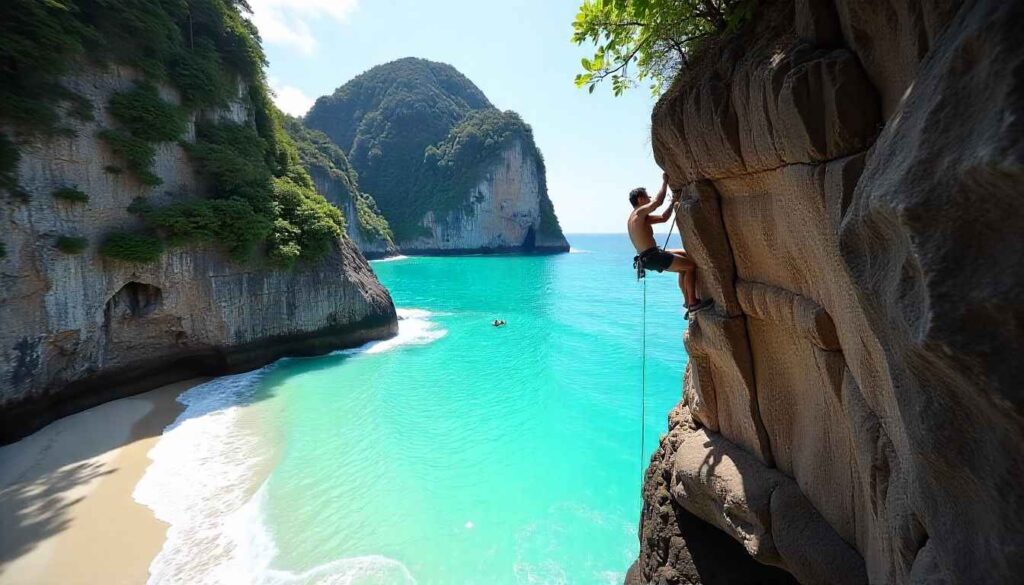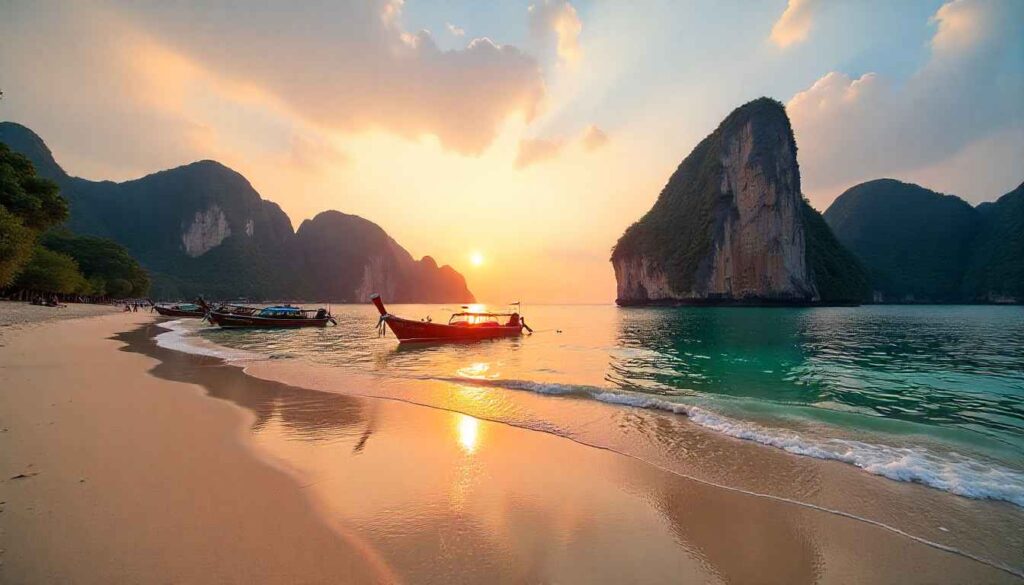The scent of saltwater and frangipani blossoms hangs in the warm air. In the distance, the silhouettes of limestone karsts rise from the emerald sea like ancient sentinels. This is Ao Nang. While it serves as the bustling heart of the Krabi province, it is also, at the same time, so much more than just a town on a map. It’s a feeling. It’s your gateway to some of the planet’s most stunning seascapes.
This comprehensive guide to Ao Nang is designed to serve as your personal travel planner. We will walk you through everything you need to know. You will learn about the best times to visit, how to navigate the area, and where to find those picture-perfect moments. More importantly, we will help you craft an itinerary that balances vibrant energy with serene escape. So, let’s begin your journey.
Why Ao Nang is the Perfect Base for Your Krabi Adventure
Ao Nang’s primary strength is its incredible convenience. Think of it as a well-equipped launchpad for exploration. Unlike more isolated islands, Ao Nang offers a wide array of hotels, restaurants, and amenities, all within a compact, walkable strip. What’s more, from here you have direct, easy access to the world-famous Phi Phi and Hong Islands, as well as the iconic Railay Beach.
At the end of a day spent island-hopping or climbing sheer cliffs, you can return to the comfort of a great meal, a lively market, or a comfortable resort. It provides a perfect blend of action and relaxation, making it ideal for first-time visitors to Southern Thailand and seasoned travelers alike.

Best Time to Visit Ao Nang: Sun or Savings?
Getting your timing right makes all the difference. Ao Nang has a tropical climate, characterized by distinct seasons.
- High Season (November to April): This is the dry, sunny period. You can expect blue skies and calm seas, making it perfect for beach days and boat trips. Consequently, this is also the busiest and most expensive time. If you crave perfect weather and don’t mind the crowds, this is your window.
- Shoulder Season (May & October):These months can be a wonderful sweet spot. You might experience short, heavy showers, but you’ll also enjoy fewer tourists and lower prices. The landscape is incredibly lush and green after the rains.
- Low Season (June to September):This is the rainy season. While you’ll find the deepest discounts and the quietest beaches, it’s worth noting that some activities may be weather-dependent. For instance, boat trips to certain islands can be canceled due to rough seas. On the bright side, though, it rarely rains all day, every day.
Getting To and Around Ao Nang: A Logistics Primer
Reaching Ao Nang
Your international gateway is Krabi International Airport (KBV). It’s a modern, small airport located approximately 40 minutes from Ao Nang. From the airport, you have several options:
- Shared Minivan:The most economical choice. Book a seat at the counter right outside the arrivals hall.
- Private Taxi: More expensive but offers door-to-door convenience.
- Pre-Booked Transfer:Often the best value for peace of mind, especially if you’re arriving tired
Navigating the Town and Beyond
Once you’re in Ao Nang, getting around is straightforward.
- On Foot: The main beach road is very walkable. You’ll find most shops, restaurants, and tour agencies lined up here.
- Tuk-Tuks & Songthaews: These are the local taxis. Always agree on a price before you get in. Red songthaews (shared pickup truck taxis) also run fixed routes to nearby areas like Krabi Town.
- Long-Tail Boats: This is the quintessential way to travel between beaches. You can hire a boat from the main beach to take you to Railay Beach, Poda Island, or Phra Nang Cave Beach. It’s an experience in itself.
- Scooter Rental: For the independent traveler, renting a scooter offers freedom. You can explore hidden beaches and local villages at your own pace. Always wear a helmet and drive defensively.
Where to Stay in Ao Nang: Finding Your Perfect Zone
Ao Nang isn’t just one homogenous strip. It has different areas, each with its own vibe.
The Vibrant Main Strip
If you want to be in the heart of the action, stay on or just off the main beach road. You’ll have instant access to restaurants, shopping, and the pier. This area is best for those who love energy and convenience.
The Serene Hillside Resorts
For a more luxurious and tranquil escape, look at the resorts nestled in the hills overlooking the bay. They offer breathtaking views, stunning pools, and a sense of seclusion. You will need to rely on taxis or hotel shuttles to get to the main street, but the peace is often worth it.
The Quiet Nopparat hara Beach
Just to the south of Ao Nang main beach, Nopparat Thara is a longer, quieter beach. Because it’s protected as a national park, development is limited. As a result, it’s ideal for families or couples seeking a more relaxed atmosphere. Even better, it’s still just a short taxi ride away from the action
The Unmissable Experiences: Your Ao Nang Bucket List
Now that you have a sense of the place, let’s dive into the adventures that make this region so special.

1. Island Hopping from Ao Nang Pier
This is the number one activity. You can book a group tour or charter a private long-tail boat. A typical 4-Island Tour often includes:
- Phra Nang Cave Beach: Home to a sacred fertility shrine and stunning limestone caves.
- Chicken Island: Named for its distinctive rock formation that looks like a chicken’s head.
- Tup Island: At low tide, a stunning sandbar emerges, connecting two islands. You can literally walk across the ocean floor.
- Poda Island: A picture-perfect island with soft white sand and great snorkeling spots.
For a more secluded experience, ask about trips to the Hong Islands. Their stunning lagoons are worth the extra travel time.
2. Rock Climbing in Railay
Just a 10-minute boat ride away, Railay is a world-renowned rock climbing destination. Whether you’re a complete beginner or an expert, there are routes for you. Local operators offer half-day introductory courses that include all gear and instruction. The feeling of reaching a ledge and looking out over the Andaman Sea is unforgettable.
3. Exploring the Emerald Pool and Hot Waterfalls
Venture inland for a different kind of natural wonder. The Emerald Pool is a natural mineral pool in the middle of the jungle, with water that’s a stunning shade of green. A short walk away, the Hot Waterfalls feature streams of warm water bubbling up from the ground. It’s a unique and relaxing experience. You can book this as a half-day tour, often combined with a visit to the Tiger Cave Temple.
4. Witnessing the Magic of the Blue Pool
While you’re visiting the Emerald Pool, make the extra effort to see the Blue Pool (Sa Morakot). It’s a fragile, crystal-blue pool, but be warned: swimming is strictly prohibited as the water is highly mineralized and can damage the ecosystem. It’s a sight to behold, not to touch.
Ao Nang’s Culinary Scene: From Street Food to Sunset Dining
The food in Ao Nang is a highlight. You can eat incredibly well on any budget.
- Local Eateries: Look for small, family-run restaurants just off the main strip. This is where you’ll find authentic and affordable Pad Thai, Tom Yum Goong (spicy shrimp soup), and Green Curry.
- Befront Restaurants: For a memorable experience, book a table at a restaurant right on the sand. Enjoy fresh seafood and a cocktail as you watch the sunset paint the sky.
- Night Market: A must-visit for any food lover. The Ao Nang Night Market is a bustling affair where you can sample a dozen different dishes for a few dollars. Try grilled skewers, fresh spring rolls, and mango sticky rice.
Practical Tips for a Smooth Trip
A little local knowledge goes a long way.
- Currency: The Thai Baht (THB). While credit cards are widely accepted in hotels and larger restaurants, it’s still important to carry cash for markets, street food stalls, and small shops.
- Bargaining: It’s expected in markets and for non-metered transport like tuk-tuks. Be polite, smile, and be prepared to walk away if the price isn’t right.
- Dress Code: When it comes to dress code, especially at temples, be mindful of local customs. In particular, ensure your shoulders and knees are covered. It’s a sign of respect.
- Stay Hydrated: The heat and humidity can be intense. Always carry a bottle of water with you.
Read more about Ao Nang Travel Guide for First-Timers (Krabi, Thailand) Tripiwi.
Conclusion: Your Ultimate Guide to Ao Nang Awaits
Ao Nang is more than just a dot on Thailand’s stunning coastline. It is a feeling of warm sand between your toes, the taste of a spicy-sweet-sour symphony, and the awe-inspiring sight of limestone giants piercing a tropical sky. This ultimate guide to Ao Nang has given you the map—the practical knowledge to navigate its waters, its trails, and its vibrant culture.
The real adventure, however, begins when you step off the boat onto a deserted sandbar, or when you find that perfect, quiet spot to watch the long-tail boats bobbing in the sunset. Your story here is waiting to be written. And when you return, perhaps you’ll be inspired to share a taste of your journey with friends and family. We’d be delighted if you shared your culinary creations with us, over more about the best things to do in Krabi and Ao Nang from Journey era.
All images are generated by Freepik.

